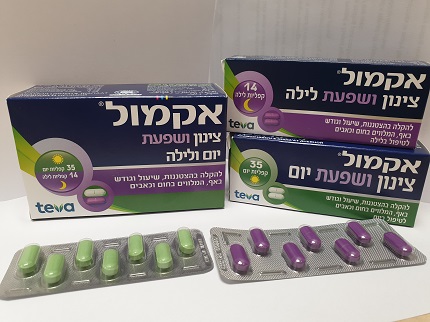Quest for the right Drug

אקמול צינון ושפעת לילה ACAMOL TSINUN & SHAPA'AT NIGHT (CHLORPHENIRAMINE MALEATE, DEXTROMETHORPHAN HYDROBROMIDE, PARACETAMOL, PSEUDOEPHEDRINE HYDROCHLORIDE)
תרופה במרשם
תרופה בסל
נרקוטיקה
ציטוטוקסיקה
צורת מתן:
פומי : PER OS
צורת מינון:
קפליות : CAPLETS
עלון לרופא
מינוניםPosology התוויות
Indications תופעות לוואי
Adverse reactions התוויות נגד
Contraindications אינטראקציות
Interactions מינון יתר
Overdose הריון/הנקה
Pregnancy & Lactation אוכלוסיות מיוחדות
Special populations תכונות פרמקולוגיות
Pharmacological properties מידע רוקחי
Pharmaceutical particulars אזהרת שימוש
Special Warning עלון לרופא
Physicians Leaflet
Pharmacological properties : תכונות פרמקולוגיות
Pharmacodynamic Properties
5.1 Pharmacodynamic properties Pharmacotherapeutic group: Expectorants, ATC code: N02B E51 Pseudoephedrine Pseudoephedrine has direct and indirect sympathomimetic activity and is an orally effective upper respiratory tract decongestant. Pseudoephedrine is substantially less potent than ephedrine in producing both tachycardia and elevation of systolic blood pressure and considerably less potent in causing stimulation of the central nervous system. Paracetamol Paracetamol has analgesic and antipyretic actions but only weak anti-inflammatory properties. This may be explained by presence of cellular peroxides at sites of inflammation which prevent inhibition of cyclo-oxygenase by paracetamol. At other sites associated with low levels of cellular perioxides, e.g. pain, fever, paracetamol can successfully inhibit prostaglandin biosynthesis. Dextromethorphan hydrobromide ATC code: R05DA09 Dextromethorphan Hydrobromide is a cough suppressant which has a central action on the cough centre in the medulla. It has no analgesic properties and little sedative activity. Dextromethorphan Pharmacotherapeutic group: Cough suppressant Chlorphenamine ATC code R06AB04 Chlorpheniramine is a potent antihistamine (H1-antagoonist).. Antihistamines diminish or abolish the actions of histamine in the body by competitive reversible blockade of histamineH1- receptor sites on tissues. Chlorphenamine also has anticholinergic activity. Antihistamines act to prevent the release of histamine, prostaglandins and leukotrienes and have been shown to prevent the migration of inflammatory mediators. The actions of chlorphenamine include inhibition of histamine on smooth muscle, capillary permeability and hence reduction of oedema and wheal in hypersensitivity reactions such as allergy and anaphylaxis.
Pharmacokinetic Properties
5.2 Pharmacokinetic properties Pseudoephedrine Pseudoephedrine is partly metabolised in the liver by N-demethylation to norpseudoephedrine, an active metabolite. Pseudoephedrine and its metabolite are excreted in the urine: 55% to 75% of a dose is excreted unchanged. The rate of urinary excretion of pseudoephedrine is accelerated when the urine is acidified. Conversely as the urine pH increases, the rate of urinary excretion is slowed. Paracetamol Peak plasma paracetamol concentration usually occurs between 30 and 90 minutes after oral ingestion. Paracetamol is distributed uniformly throughout most body fluids and is only 15 to 25 per cent bound to plasma proteins. The plasma half life of paracetamol after therapeutic doses is in the range of 1 to 3 hours. Dextromethorphan hydrobromide Dextromethorphan hydrobromide is well absorbed from the gastrointestinal tract. Dextromethorphan undergoes rapid and extensive first-pass metabolism in the liver after oral administration. Genetically controlled O-demethylation (CYD2D6) is the main determinant of dextromethorphan pharmacokinetics in human volunteers. It appears that there are distinct phenotypes for this oxidation process resulting in highly variable pharmacokinetics between subjects. Unmetabolised dextromethorphan, together with the three demethylated morphinan metabolites dextrorphan (also known as 3-hydroxy-N-methylmorphinan), 3- hydroxymorphinan and 3-methoxymorphinan have been identified as conjugated products in the urine. Dextrorphan, which also has antitussive action, is the main metabolite. In some individuals metabolism proceeds more slowly and unchanged dextromethorphan predominates in the blood and urine. Chlorphenamine is well absorbed from the GI tract, following oral administration. The effects develop within 30minutes, are maximal within 1 to 2 hours and last 4 to 6 hours. The plasma half-life is estimated to be 12 – 15 hours. There is significant plasma protein binding. The drug is largely inactivated in the liver and excreted as metabolites in the urine. Chlorphenamine is metabolised to the monodesmethyl and didesmethyl derivative. About 22% of an oral dose is excreted unchanged in the urine. Only trace amounts have been found in the faeces.

שימוש לפי פנקס קופ''ח כללית 1994
לא צוין
תאריך הכללה מקורי בסל
לא צוין
הגבלות
לא צוין
מידע נוסף
עלון מידע לצרכן
21.06.15 - עלון לצרכן אנגלית 21.06.15 - עלון לצרכן עברית 21.06.15 - עלון לצרכן ערבית 11.10.22 - עלון לצרכן 11.10.22 - עלון לצרכן עברית 12.12.22 - עלון לצרכן אנגלית 12.12.22 - עלון לצרכן עברית 12.12.22 - עלון לצרכן ערבית 26.09.23 - עלון לצרכן 06.12.23 - עלון לצרכן אנגלית 06.12.23 - עלון לצרכן עברית 06.12.23 - עלון לצרכן ערבית 20.03.24 - עלון לצרכן עברית 17.07.24 - עלון לצרכן אנגלית 17.07.24 - עלון לצרכן עברית 17.07.24 - עלון לצרכן ערבית 01.08.24 - עלון לצרכן עברית 17.08.14 - החמרה לעלון 07.09.22 - החמרה לעלון 26.09.23 - החמרה לעלון 21.03.24 - החמרה לעלון 01.08.24 - החמרה לעלוןלתרופה במאגר משרד הבריאות
אקמול צינון ושפעת לילה